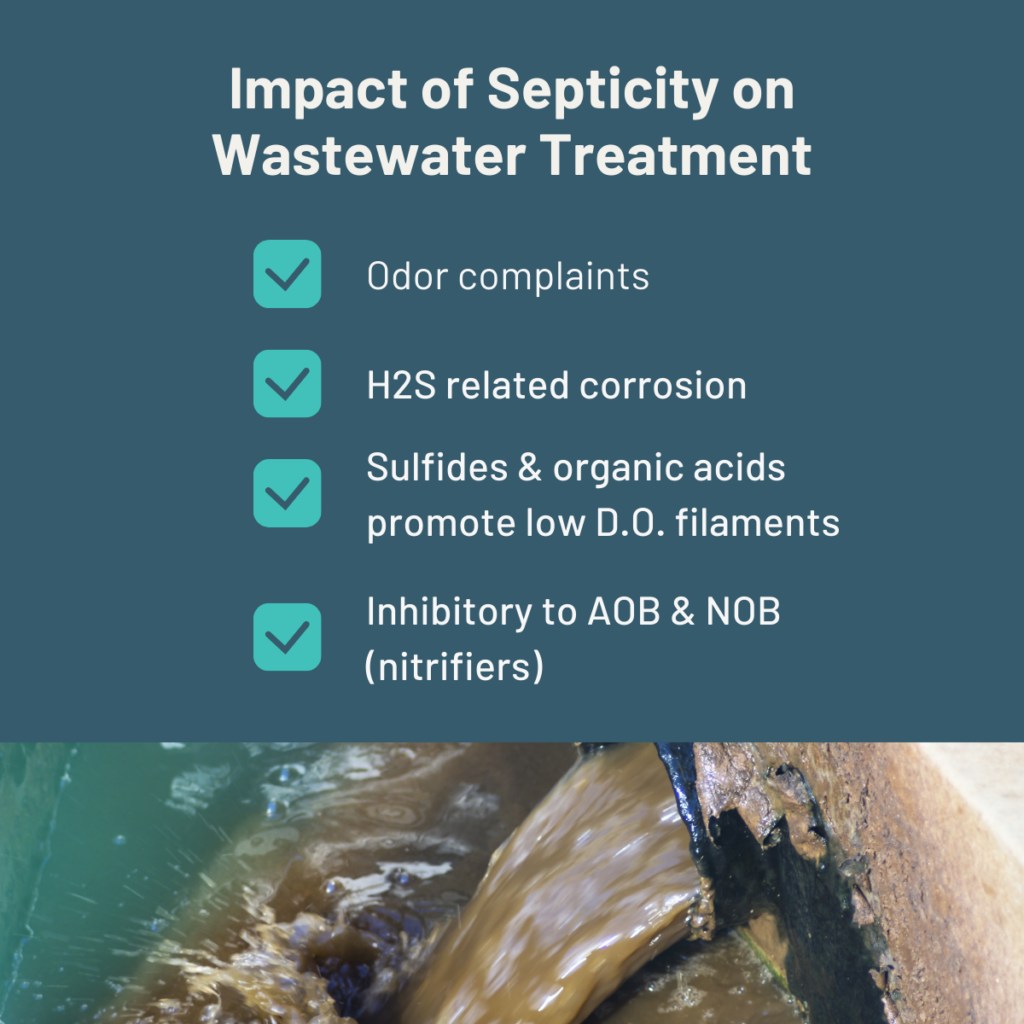
Wastewater treatment is a complex process that relies on a delicate balance of physical, chemical, and biological factors. At the heart of most conventional wastewater treatment plants are microorganisms that break down organic waste. However, when this balance is disrupted, a condition known as “septicity” can arise, posing a significant challenge to the treatment process.
What Makes Water “Septic”?
Speticity in wastewater occurs when oxygen is depleted, and the water becomes anaerobic (lacking in oxygen) yet microbes continue to grow on the organics present. This can happen in wastewater collection systems, especially in long pipes or pumping stations where the wastewater has a long retention time. As the dissolved oxygen is consumed and redox potentials drop below 0, the naturally occurring aerobic bacteria decrease and fermentative and other anaerobic cultures thrive,
These anaerobic bacteria break down organic matter through a different pathway, producing a variety of foul-smelling compounds, including hydrogen sulfide (H2S), ammonia (NH3), and volatile organic acids. Hydrogen sulfide is particularly problematic as it gives off the characteristic “rotten egg” smell and is corrosive to concrete and metal infrastructure.
The Impact of Septicity on Aerobic Microorganisms
The shift from an aerobic to an anaerobic environment has a profound impact on the microorganisms that are the workhorses of aerobic wastewater treatment. Here’s how septicity negatively affects them:
- Toxicity: The products of anaerobic decomposition, such as hydrogen sulfide, can be toxic to the beneficial aerobic bacteria. Hydrogen sulfide can inhibit the enzymes crucial for their metabolic processes.
- pH Changes: The production of organic acids can lower the pH of the wastewater, creating an unfavorable acidic environment for many aerobic microorganisms, which typically thrive in a more neutral pH range.
- Reduced Treatment Efficiency: With the inhibition of aerobic microorganisms, the overall efficiency of the wastewater treatment plant plummets. The breakdown of organic waste slows down, leading to higher levels of biochemical oxygen demand (BOD) and total suspended solids (TSS) in the effluent, which can violate regulatory discharge limits.
- Sludge Bulking: Septicity contributes to filamentous organism growth and associated sludge bulking. This occurs when certain filamentous bacteria, which can tolerate low-oxygen conditions, proliferate and form a bulky, difficult-to-settle sludge. This makes it challenging to separate the treated water from the solid waste, further impairing the treatment process.
Mitigating Septicity
Preventing and managing septicity is crucial for maintaining an efficient and effective wastewater treatment system. Strategies to mitigate septicity include:
- Odor Control Chemistry: Using chemical additives, such as nitrates or iron salts, can help control odor by either providing an alternative electron acceptor for bacteria or precipitating out sulfides.
- Aeration: Introducing oxygen into the wastewater collection system can help maintain aerobic conditions and prevent septicity from developing. Wet wells and lift stations are ideal locations to introduce aeration/oxygen.
- Shorter Retention Times: Optimizing the collection system to reduce the time wastewater spends in pipes and pumping stations can minimize the opportunity for anaerobic conditions to develop.
In conclusion, septicity is a serious concern in wastewater treatment. By understanding what causes it and how it impacts the microorganisms that drive the treatment process, we can take proactive measures to ensure the health and efficiency of our wastewater treatment systems, protecting both public health and the environment.
